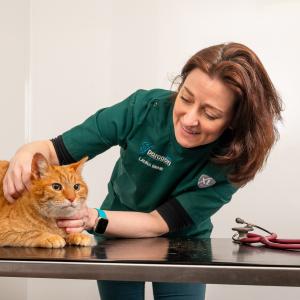
by Vet Laura Binnie

World Spay Day is coming up this month when we raise awareness about the advantages of spaying female pets.
Spaying female dogs (bitches) and cats (queens) stops them having unwanted litters and can prevent serious illness.
It involves removing both ovaries and uterus (ovario-hysterectomy) while the animal is under full general anaesthesia.
Bitch spays are usually performed through the midline (the line between their abdominal muscles) and cat spays are via a small hole in their left flank.
Spaying is usually a day procedure. When your bitch is presented for neutering, we will first check their overall health, that they are large enough for their breed, ask when their last season was (it must have finished 9 weeks before the surgery) and if they have any signs of a false pregnancy (mammary development, milk at teats, mothering toys etc). It may be recommended the surgery is postponed.
Spays are usually first on the day’s operation list. They are given medication to make them relaxed, then via an intravenous catheter, they are put under general anaesthetic and ‘prepped’ for surgery. The fur is clipped from their belly (bitches) or flank (cats) and their skin is cleaned so no bacteria remains, a very important step in preventing infection.
The veterinary surgeon will then perform the ovario-hysterectomy operation in about 20-40 minutes. The patient is monitored closely throughout by registered veterinary nurses. Afterwards they are kept warm and calm, offered some food and checked for any wound bleeding or additional pain relief needs.
They are usually home by mid-afternoon or early evening. There should be no jumping, rushing around, swimming or licking for about two weeks.
They go home with oral pain relief and will have a post op check 3 days and sometimes 10 days later.
We will recommend your pet changes to a ‘neutered’ pet food range to reduce the risk of them gaining weight.
Neutering is advisable for the purpose of population control if you are not intending to breed from your pet. Unplanned breeding can often lead to problems during pregnancy and labour.
Other benefits to neutering include preventing problems with seasons and false pregnancies, reducing the risk of them developing mammary and ovarian tumours, and it prevents a life-threatening condition called Pyometra.
We usually recommend your bitch is fully skeletally mature before we neuter them, but we can neuter cats from as early as four months old. But this advice may vary depending on each individual and any risk factors.